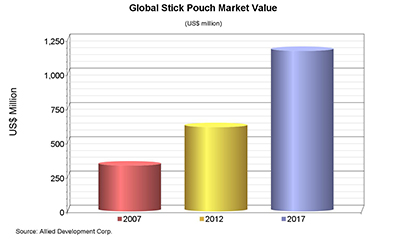Stick Pouches | Market Trends to 2017
- Published: April 08, 2014, By Debbie Donberg
A new study from Allied Development Corp. examines the global trends and environmental impact of this convenient packaging
Named for its shape and known for its convenience, the stick pouch is the subject of a new study from Burnsville, MN-based Allied Development Corp.: Stick Pouches 2013 to 2017—Global Markets, Economics, Environmental Impact, and Technology.
The stick pouch was first commercialized in Japan in the 1970s for dry condiments. According to the study, it has grown to become an accepted package type around the world, but there has not been a great deal of participation in North America. This in-depth study includes:
- A technology section examining equipment concepts, package designs, packaging materials, processing techniques, competitive responses, and suppliers;
- A detailed economic and environmental comparison of ketchup packaged in a stick pouch vs a sachet;
- Market trends and drivers, market statistics, and projections for the future of stick pouches; and
- Profiles of companies that supply equipment to form and fill stick pouches and companies that provide contract packaging and have a focus on stick pouches.
Segmenting the world into four geographic regions—Japan, North America, Europe, and other countries—the study offers real-life examples of products, equipment, and companies as well as numerous chart and diagrams to illustrate its findings.
Looking at Both Sides
The study offers a balanced approach when discussing both the characteristics of stick pouches as well as trends. One example: While the convenience of the pouches is considered one of their main attributes, the study points out that products providing convenience typically require more time and effort to prepare, which increases their price. Also, consumer demands for convenience tend to be subject to changes in economic times.
Thus, the economic recession in 2008 and 2009 had a negative effect on the demand for convenience products. The report sees the global economy growing, and this should lead to an increasing demand for convenience, which is expected to benefit stick pouches through 2017.

Another area with two sides is technology, which is driven primarily by the size and shape of stick pouches. This provides important competitive advantages but also leads to many of the industry's technical challenges. And, while stick pouches can only be used for the single-serve market, which is a limitation, this “required focus on filling very small quantities of product has generated very accurate filling technologies….”
Growth Areas
Two major areas—healthcare and security—show promise for continued growth in stick pouches. Many prescription and nonprescription medications, gels, and ointments can be packaged in the single-dose pouches, which has precise dispensing control. It is predicted that dry healthcare products will add 24.0% of all new stick pouch volume through 2017.
In security applications, shaped stick pouches are useful as an anti-counterfeiting measure, the study says, explaining that it is difficult for counterfeiters to copy a uniquely shaped stick pouch without purchasing expensive laser equipment to copy the shaped stick pouch design.
Global stick pouch volume grew 11.2%/yr from 2007 to 2012, and it is expected to grow 12.2%/yr through 2017 to 684.0 billion units. For a complete picture of this portion of the packaging market, contact Allied Development at 952-898-2000 or sales@allied-dev.com. The cost of the study US $4,495.












